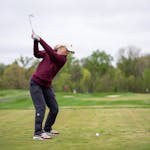 See
more of the story
See
more of the story
John Anderson is hopeful his 40th season as the Gophers baseball coach will get started at some point in February. The 39th did not amount to much, shut down by the pandemic in mid-March, with the Gophers at 8-10 in a rugged nonconference schedule and still two weeks from a Big Ten opener.
Four decades in, any coach would be permitted to suggest that he or she had seen it all, but that's far from the truth for Anderson in 2020.
Most dramatically, he has seen the change that COVID-19 has made to our planet, and most interestingly, he has followed the changes from Major League Baseball that will transform the relationship between colleges and the pros.
"Baseball is more determined to take charge of identifying and developing the best prospects than in the past," Anderson said. "And when this new approach shakes out, I'm confident that there's going to be a significant uptick in talent for college baseball — particularly in Power Five baseball."
That's the football term for the SEC, Big Ten, ACC, Big 12 and Pac-12, and it also can be applied to the top echelon of college baseball.
There are two big-picture items in MLB's upcoming changes:
The number of official minor league teams is being reduced from 160 to 120, and the number of rounds in the draft are being reduced from what had been 40 to 25.
"They only had the five-round draft this summer because of the pandemic, of course," Anderson said. "That means a lot of juniors that would've signed in a normal year will be back as seniors in 2021, if we get a chance to play.
"Longer term, there are also going to be juniors that would've been taken between [rounds] 26 and 40 and maybe signed that are going to come back as seniors."
MLB will save a few bucks by reducing the draft, but Anderson thinks this also has much to do with it:
"They have found out that college baseball does a very good job of developing players. We have the analytical equipment, we have excellent facilities, and we have the bright young people with college degrees that know how to get the information across to the players.
"Major league teams have been hiring our coaches to work in their organizations, hiring our people to work in their evaluation and research areas."
Anderson named five of his team managers/analysts since 2014 that are now with big-league organizations: Preston Higbe (Seattle), Kan Ikeda (Detroit), Sam Niedorf (Texas), Nick Kropidlowski (Cincinnati) and Ryan Goll (Baltimore).
"I'm getting calls frequently, asking, 'Do you have any more like those people?' " Anderson said. "I never fought against the analytics, the metrics, but it's been the last four, five years that I'm all in on the idea that the information — when used properly — can make a real difference with our players."
Leagues will change
The MLB changes are going to have a sizable impact on independent leagues and established collegiate leagues such as Northwoods, with its 22 teams — in the Midwest, and Thunder Bay in Ontario.
Three rookie leagues have lost their affiliated status: Appalachian, New York-Penn and the Pioneer (in the West).
The Appy will be a 10-team collegiate league, the Pioneer will be an independent league and MLB partner, and four teams from the New York-Penn will be part of the new MLB Draft League.
The plan for that league is to assemble the top prospects eligible for the upcoming draft — high school seniors to college juniors — to compete from Memorial Day to the draft (moving to July), and then to have the teams reconfigured with undrafted players into mid-August.
MLB will have a strong connection to the Appy League, and will encourage top college underclassmen to play there in the summer.
The sales pitch for the Appy League is going to be that MLB will provide the best in modern equipment, TrackMan and beyond, to the collegiate players invited to join these teams. Those will include Elizabethton, Tenn., the rookie league team for generations of Twins players.
That will affect the talent pools for the Cape Cod League, traditionally the top college league, and also the Northwoods. More summer activity for Division II athletes, presumably.
"Getting as many top college players together as possible … that's all about player development for the major leagues," Anderson said. "They have let other entities shape the development of baseball talent: independent groups like Perfect Game running showcases for high school kids, the summer leagues for college kids.
"I think MLB is going to be running more showcases sooner rather than later. It's getting into collegiate leagues with the Draft League and Appy League. And the 22-year-olds that don't get drafted — they are going to be playing in independent leagues, like the Pioneer, to see if they can play well enough to get signed.
"The major leagues want to have far more input throughout the developmental process than in the past."
For decades, the attitude of the major leagues was to get its prospects signed early and keep them away from college coaches who were worried about today, not a player's future.
As season 40 with the Gophers beckons (hopefully), Anderson said this of the MLB-college relationship:
"It has been better the last 10 years. And now, we're sharing information, data, they are hiring our coaches. They are impressed with what we're doing to make our players better. There's a trust."
Write to Patrick Reusse by e-mailing sports@startribune.com and including his name in the subject line.
![Minnesota Twins manager Rocco Baldelli spoke with Gophers head coach John Anderson after he threw the first pitch. ] CARLOS GONZALEZ • cgonzale](https://arc.stimg.co/startribunemedia/DDG76ST3WHMETRCDAIB525BRTM.jpg?fit=crop&crop=faces&w=550&&auto=format)




